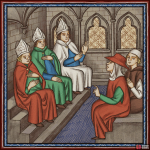Text
In the pre-Hussite period, the church owned extensive property, sometimes exceeding the wealth of the nobility or even the king himself. The church also often collected various taxes and fees, which led to conflicts not only between the church and the secular world but also within the church itself.
Besides priests, clergymen and their assistants, the church also included monks, archbishops, church officials, clerics and monks – altogether the church supported and employed about a tenth of the population.
The high costs of operation and the inability to ensure people’s welfare or salvation, along with numerous wars and plagues, led in the 14th century to a radical weakening of church power and a loss of people’s trust in the church as an institution. The first signs of the reformation movement appeared, as well as many alternative “heretical” sects or a return to old pagan traditions.
Mass at that time was more of a social event than a spiritual one. People chatted, flirted, or even made business deals. This changed only with the reformation movement and the return to “true piety” during the Hussite movement.
The declining trust in the church was also supported by the first translations of the Bible into the Czech language, thanks to which the ideas truly contained in the Bible could finally spread even among the illiterate population. The spark of revolution had been struck.


No Comments